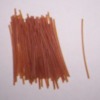I found this description of their equipment online......
Before training began, Lieutenant-Colonel Roosevelt used his political influence gained as Assistant Secretary of the Navy to ensure that 'his' volunteer cavalry regiment would be properly equipped to serve as any regular unit of the U.S. Army. For private soldiers and noncommissioned officers, this meant the M1892/98 Springfield (Krag) bolt action rifle in .30 Army (.30-40) caliber "They succeeded in getting their cartridges, revolvers, clothing, shelter-tents, and horse gear ... and in getting the regiment armed with the Krag-Jorgensen carbine used by the regular cavalry." Officers of the regiment each received a new lever-action M1895 Winchester rifle, also in .30 Army. A last minute gift from a wealthy donor were a pair of modern gas-operated M1895 Colt-Browning machine guns in 7mm Mauser caliber.
In contrast, the uniforms of the regiment were designed to set the unit apart. "The Rough Rider uniform was a slouch hat, blue flannel shirt, brown trousers, leggings, and boots, with handkerchiefs knotted loosely around their necks. They looked exactly as a body of cowboy cavalry should look." It was the 'rough and tumble' appearance and charisma that contributed to earning them the title of The Rough Riders.



